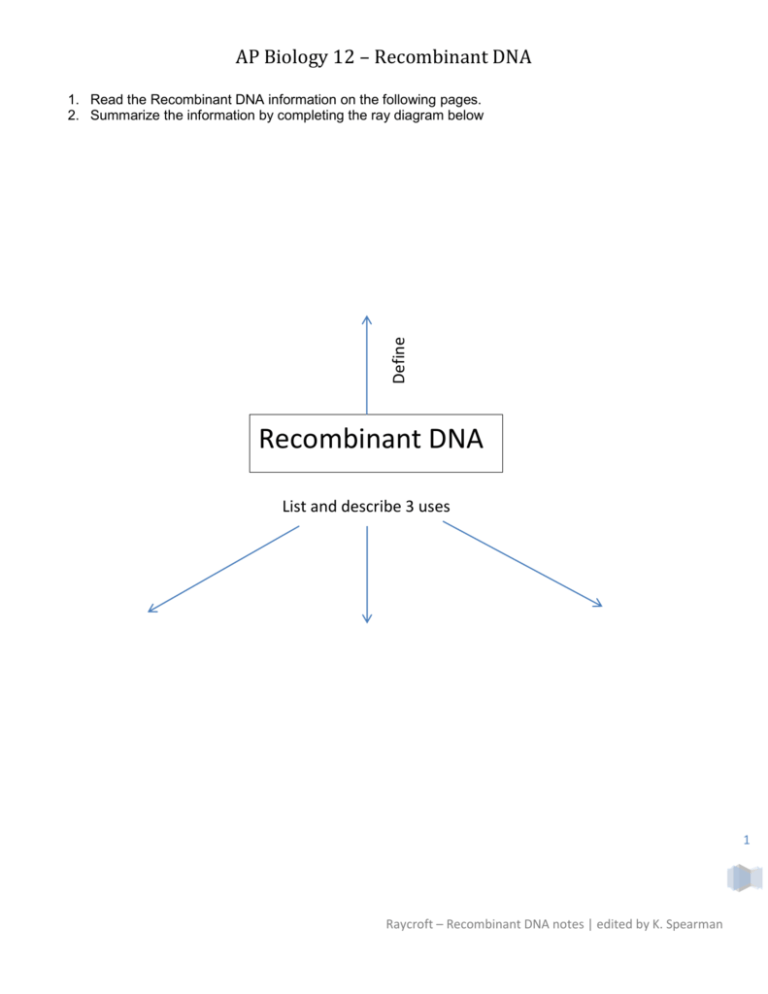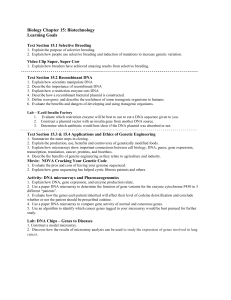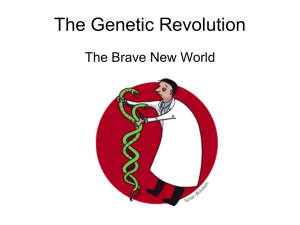Biology 12 * Recombinant DNA
advertisement

AP Biology 12 – Recombinant DNA Define 1. Read the Recombinant DNA information on the following pages. 2. Summarize the information by completing the ray diagram below Recombinant DNA List and describe 3 uses 1 Raycroft – Recombinant DNA notes | edited by K. Spearman AP Biology 12 – Recombinant DNA Biology 12 – Recombinant DNA th In the latter part of the 20 Century, humans have been purposefully bringing about genetic changes through RECOMBINANT DNA TECHNOLOGY (a major part of genetic engineering). The recombining" of the DNA from different species has allowed the production of rare proteins in large quantities (e.g. insulin). Isolating, modifying, and reinserting DNA sequences, called "Human gene therapy" is aimed at controlling or curing genetic disorders. Recombinant DNA (rDNA) is DNA in which DNA from one species (e.g. a gene coding for the protein Insulin) is inserted into the DNA of a second species (e.g. bacteria). The second species can then go on to produce proteins of the first species, and when it reproduces, it will copy the other species' DNA and pass it onto its offspring. The gene can now said to be "cloned." We can also make many copies of the DNA (“amplify”) that interest us. The genes, and in some cases their protein products, are made in quantities that are large enough for research and for practical applications. The uses of recombinant DNA include: 1. CLONING GENES: viruses and bacteria can be used to make copies of the gene(s) of another species. Huge amounts of any piece of DNA can now be made using a technique called the Polymerase Chain Reaction (PCR) • Whole organisms can now be cloned as well! 2. PRODUCING BIOTECHNOLOGY PRODUCTS: genetically engineered prokaryotic and eukaryotic cells can be used to mass produce once rare medicinal proteins and hormones as well as vaccines to prevent disease (e.g. hepatitis B). • The future may provide vaccines for such things as herpes and AIDS and many other diseases. • it allows us to produce large amounts of proteins that are very difficult to get otherwise or are usually present only in small quantities from natural sources. • e.g. human growth hormone - once took 50 pituitary glands from cadavers for a single dose. Can now be made in mass quantities, and much less expensively. • Insulin used to come from the pancreatic glands of cows and pigs. This was expensive and much less pure than the cloned human DNA available today. • tPA (tissue plasminogen activator) - a protein that activates an enzyme that dissolves blood clots, normally present in only tiny amounts, can now be made in large quantities and is routinely used to dissolve the coronary blood clots of heart attack victims. • Other Biotechnology Products include these medicines and Vaccines: Factor Used to Treat Interferons Cancer Erythropoietin Anemia Interleukin-2 Cancer Blood Clotting Factor VIII Hemophilia Human Lung Surfactant Respiratory Distress Syndrome Atrial natriuretic factor High Blood Pressure Tumor necrosis factor Cancer Vaccines • • Herpes • Hepatitis A, B, C • Lyme Disease • Whooping Cough • Chlamydia Raycroft – Recombinant DNA notes | edited by K. Spearman 2 AP Biology 12 – Recombinant DNA MAKING TRANSGENIC ORGANISMS: we can alter the DNA of bacteria, plants, and farm animals to make them more valuable and less susceptible to disease. • Bacteria is very useful in this capacity • Bacteria are used to Protect and Enhance Plants: e.g. protect plants from frost, provide more nitrogen to roots, even produce insecticides to kill insects. • Bacteria are used for Garbage Disposal: Bacteria can be engineered to eat toxic waste and clean up oils spills, filter the air, remove sulfur from coal etc. (bioremediation is the name for using organisms to clean up man’s messes) • Bacteria are used to Produce Chemicals: e.g. genetically engineered bacteria produce phenylalanine, used in the production of ‘Nutrasweet’ artificial sweetener. • Bacteria are used to Process Minerals: genetically engineered bacteria can be used to extract greater amounts of metals (e.g. U, Cu, Ag) from low-quality ores. • Transgenic plants: • Are already widely used in agriculture. The bacterium Agrobacterium, which naturally infects many plants, is used, as well as artificial vectors called protoplasts. • Over 50 types of genetically engineered plants today. Contain new genes that help resist insects, viruses, or herbicides (e.g. “Roundup” resistant wheat). Genetically engineered soybeans, cotton, alfalfa, and rice are already on the market. • Transgenic plants can also be made that are resistant to temperature extremes, drought, and salty soils. • There are transgenic plants that resist spoiling and bruising. • Transgenic animals: • by injecting DNA that codes for the uptake of bovine growth hormone (bGH) into the eggs of fish, cows (e.g. 25% greater milk production), pigs, rabbits, and sheep, bigger animals can be produced more cheaply. • “Gene Farming” refers to the use of transgenic farm animals to produce pharmaceutical drugs like human lactoferrin (absence of the gene for lactoferrin in humans causes reoccurring bacterial infections of the intestine). Transgenic cows, for example, will produce human lactoferrin in their milk. Drink the milk, and you get protection from the intestinal infections. • There are plans to produce drugs to treat cystic fibrosis, blood diseases, and cancer through this method. 4. GENE THERAPY • The idea behind gene therapy is to replace defective genes in a living organism (especially humans) with healthy genes, and is used to treat genetic disorders and diseases. • Can be “Ex Vivo” (outside living organism) or “In Vivo” (inside living organism). • In Ex Vivo gene therapy, cells are removed from the patient, treated, then returned to the patient. • Can use retroviruses to introduce the nucleic acid into the cells to be treated. • e.g. has been used to treat SCID (severe combined immunodeficiency syndrome - sufferers lack an enzyme needed for certain white blood cells). Insert the correct gene into patient’s WBC or stem cell and reinsert. • e.g. - has been used to treat liver cells in hypercholesterolemia (in this disorder, liver is unable to remove cholesterol from blood � heart attacks) • e.g. - used to make cancer patients more resistant to chemotherapy drugs) • In Vivo techniques introduce genes right into the bodies of patients. • e.g. an inhalant spray containing an adenovirus containing a gene to treat cystic fibrosis (must be reapplied regularly). • e.g. treat or cure Parkinson’s Disease by grafting dopamine-producing cells right onto the brain. • e.g. treat hemophilia with regular injections of cells that have the normal clotting-factor genes. • e.g. work is being done to see if retroviruses can be used to carry genes for cytokines (soluble hormones of the immune system) to treat cancer. • “antisense” technology may be used to turn off cancer-causing genes (oncogene) or turn off AIDS viruses. Raycroft – Recombinant DNA notes | edited by K. Spearman 3 AP Biology 12 – Recombinant DNA Making Recombinant DNA • A "vector" is something that can get the DNA from one species into the other species' DNA. Often, this can be a "plasmid", a circular piece of DNA found in some bacteria. • A human gene, such as the gene for insulin, is inserted into the plasmid and then the plasmid is taken up by bacteria. The bacteria reproduces the plasmid along with its own DNA when it reproduces, and translates the human gene, producing human protein. 4 Raycroft – Recombinant DNA notes | edited by K. Spearman









